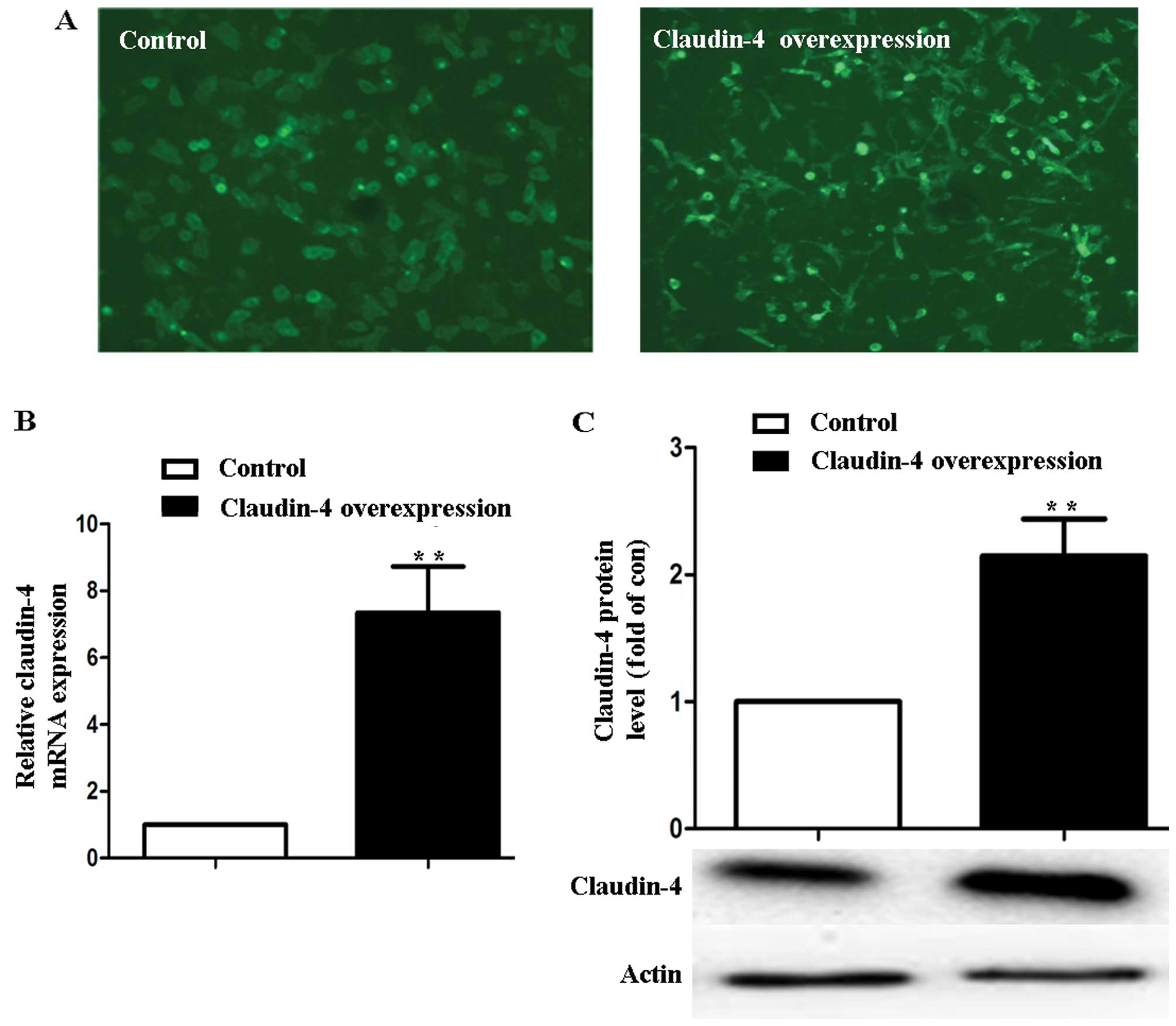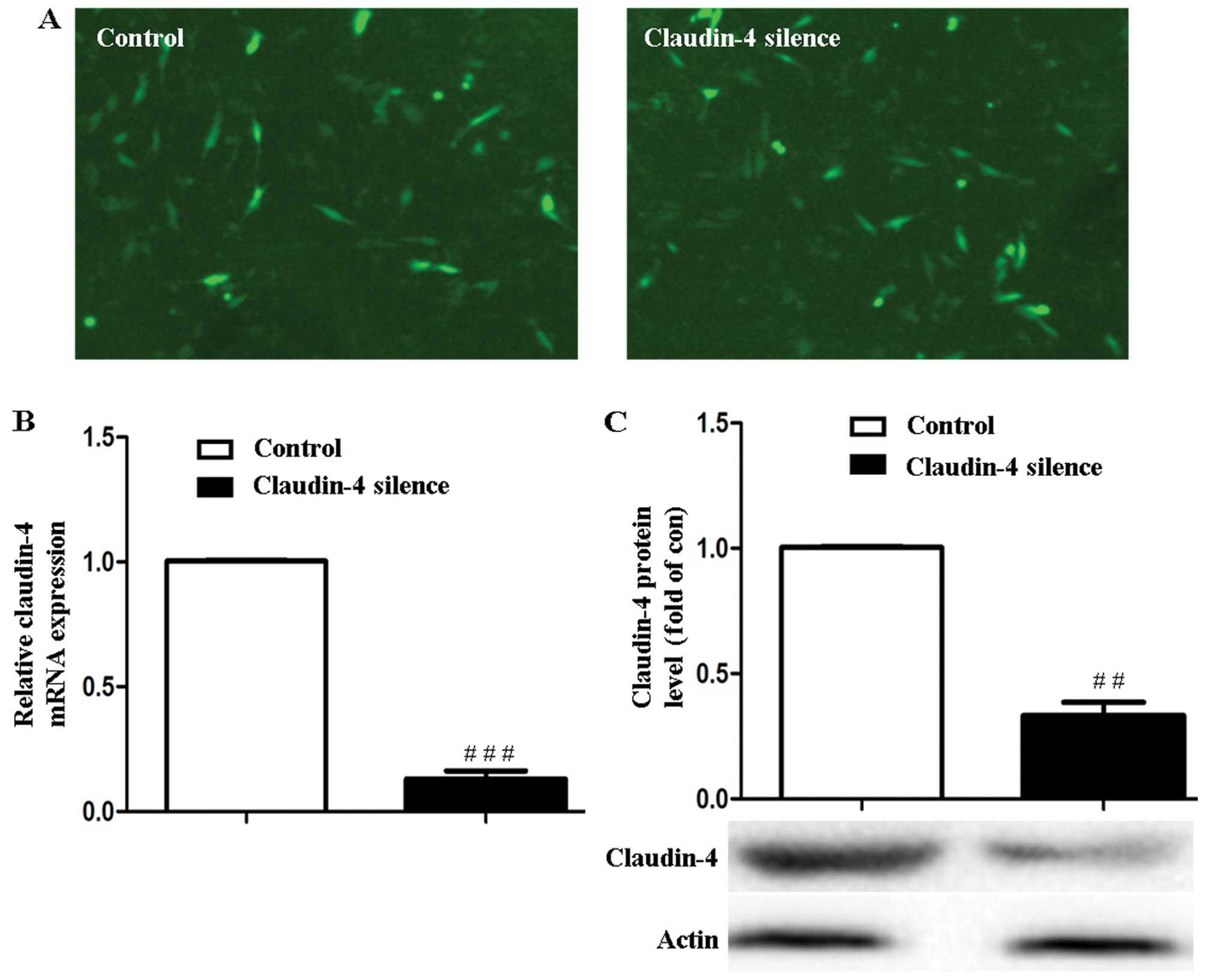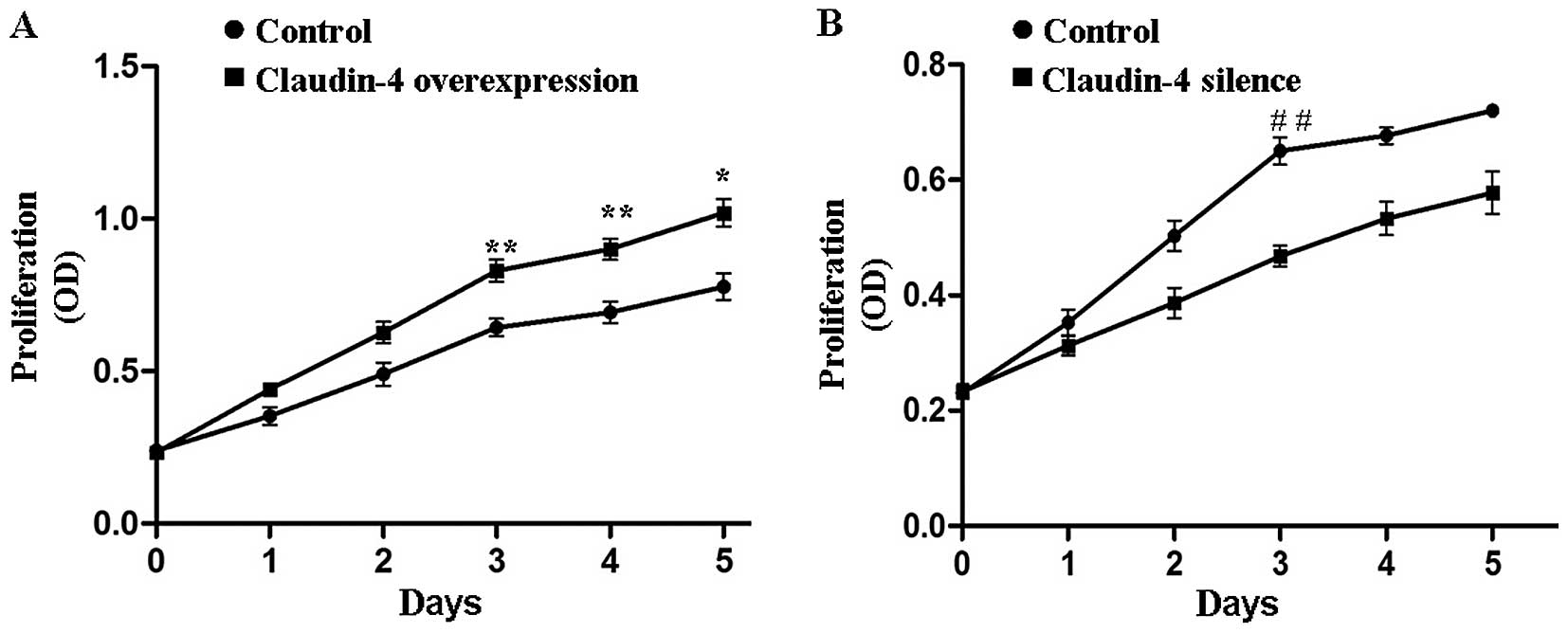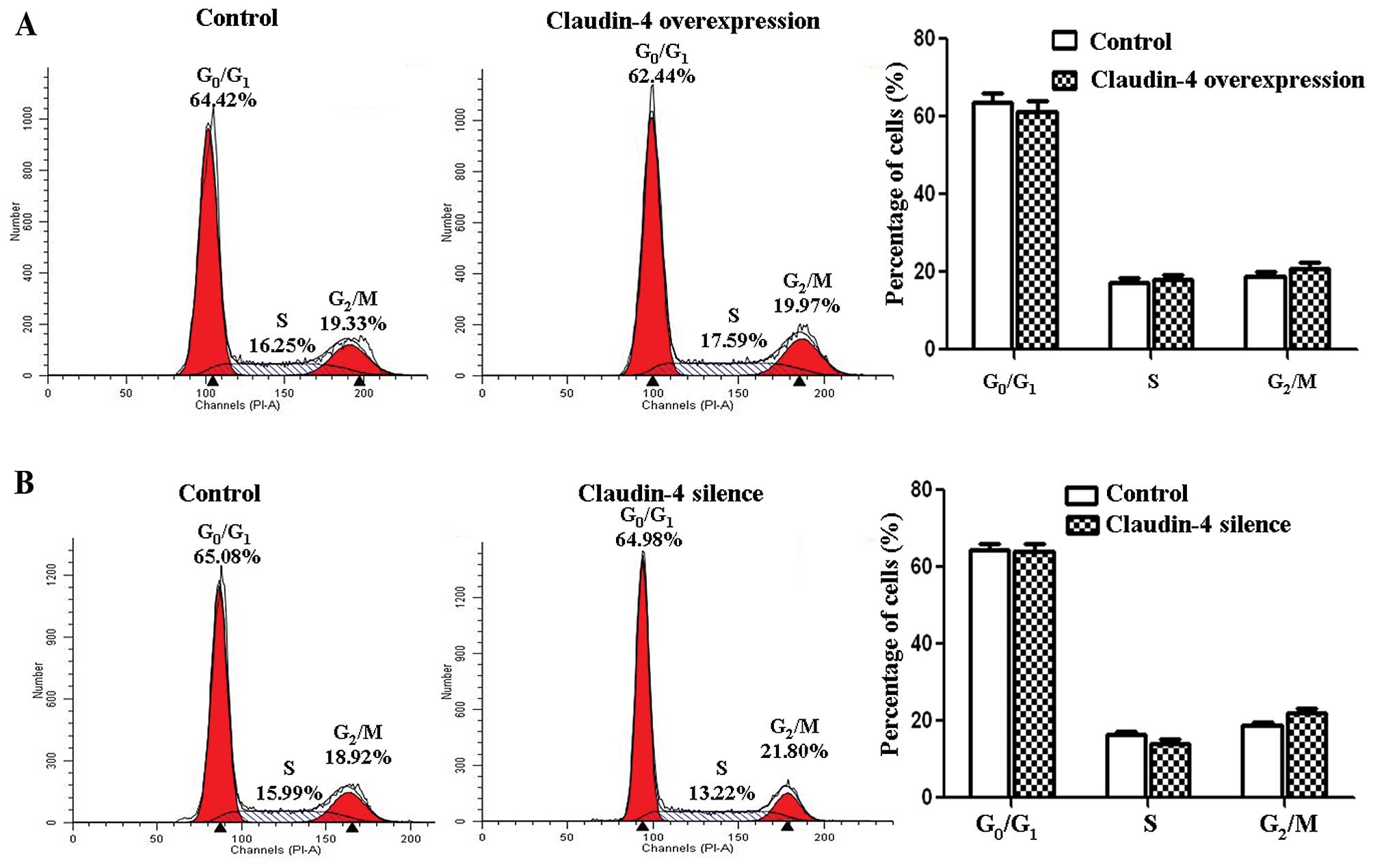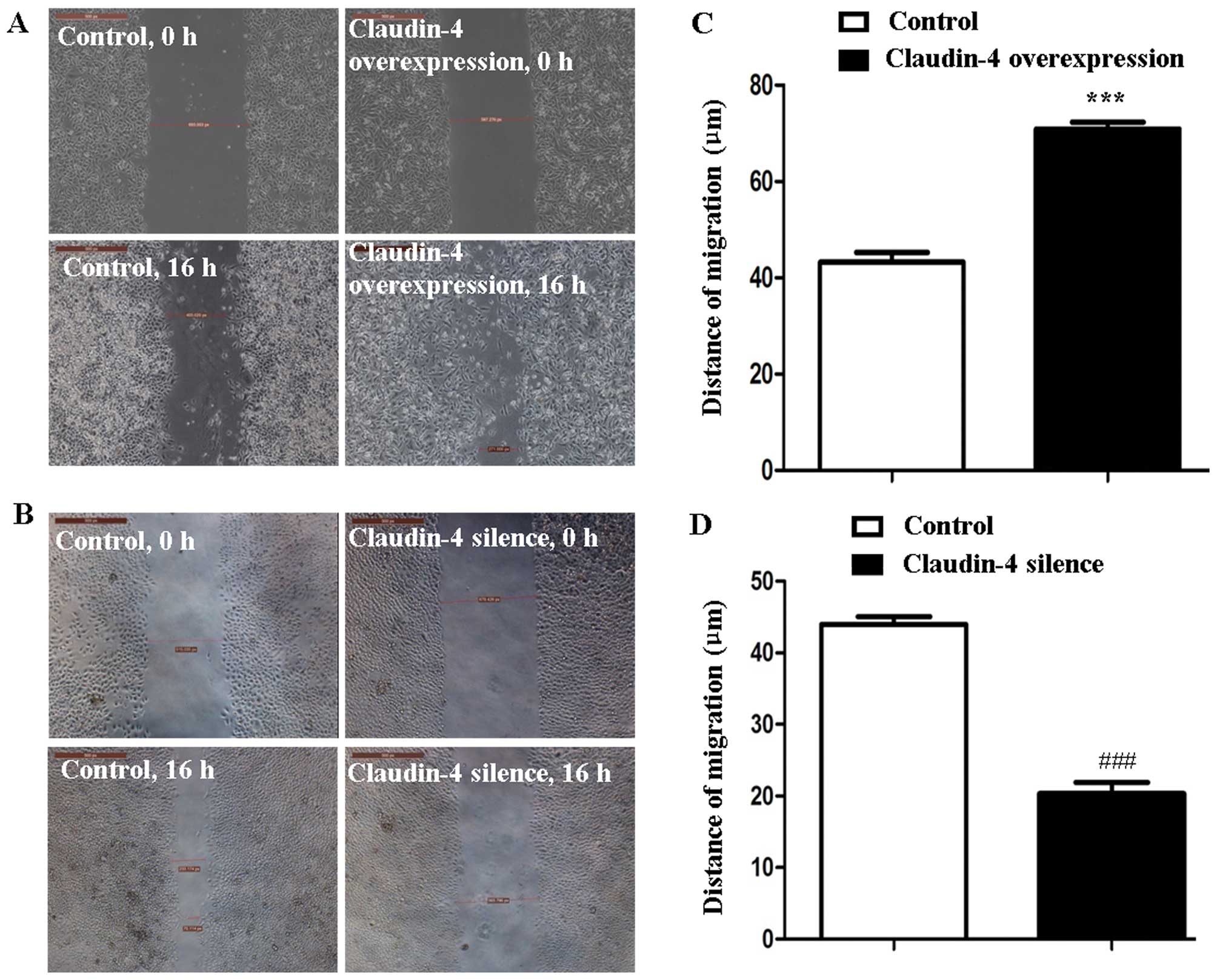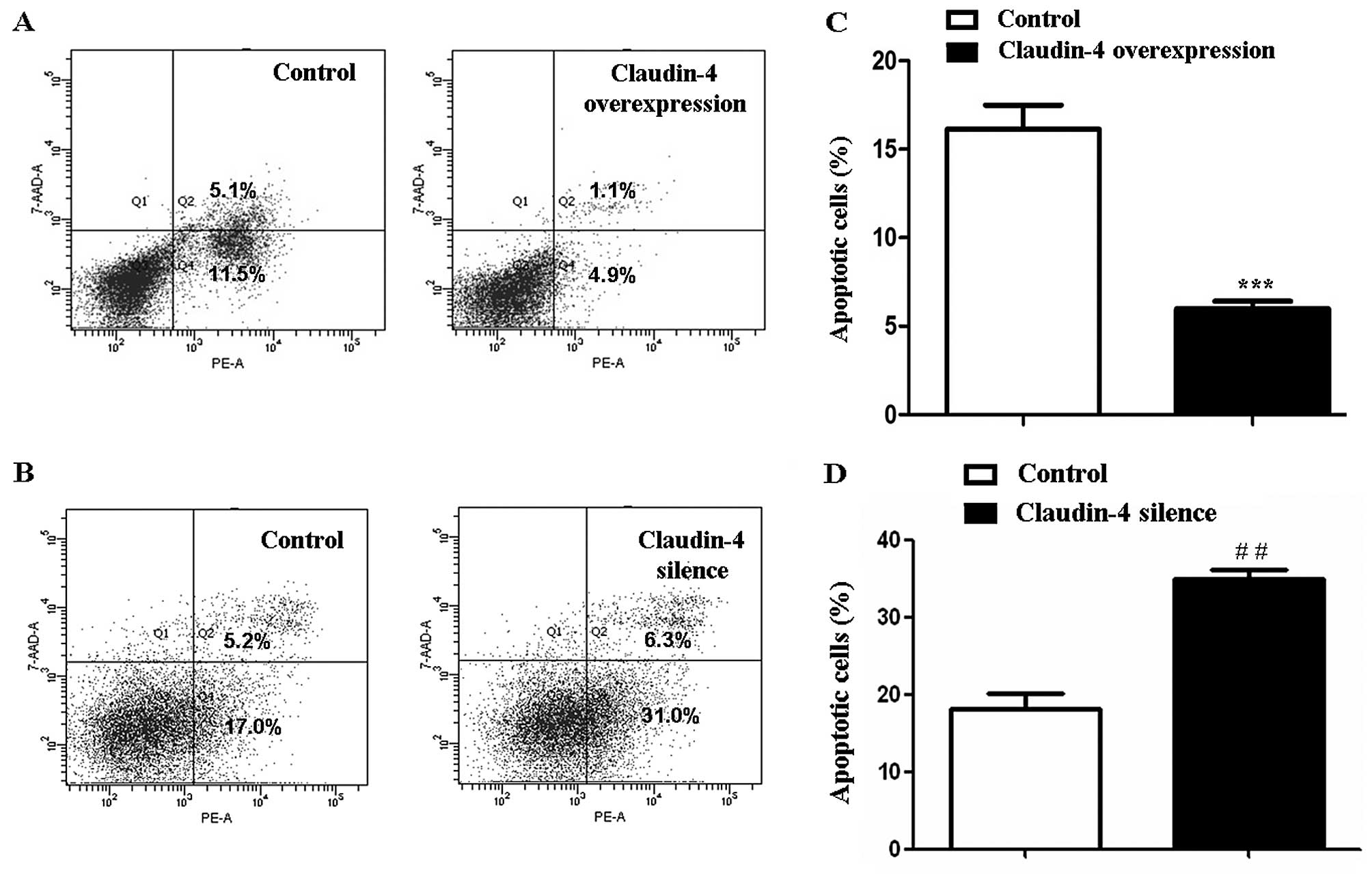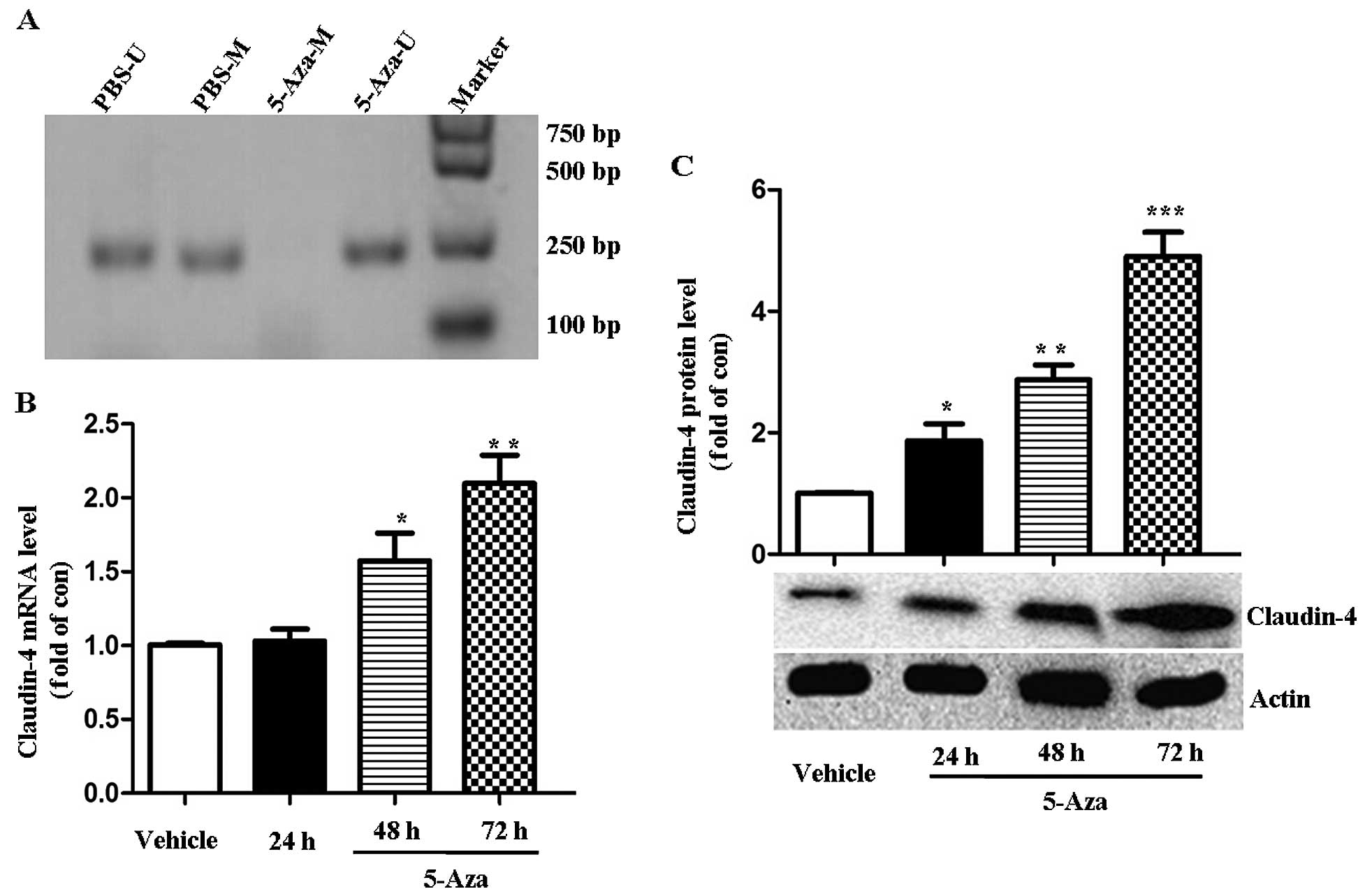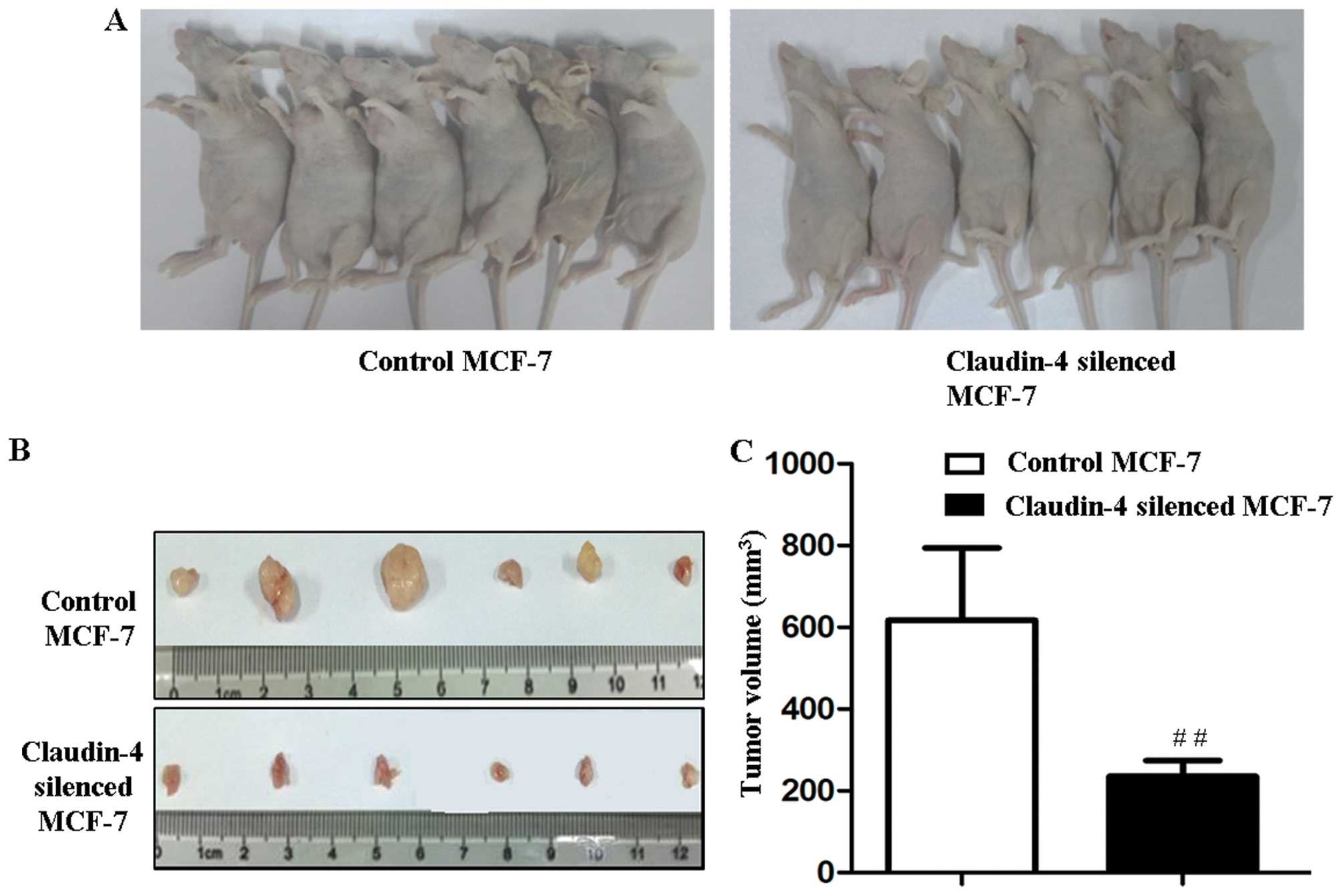Claudin-4 controls the proliferation, apoptosis, migration and in vivo growth of MCF-7 breast cancer cells
- Authors:
- Published online on: June 5, 2015 https://doi.org/10.3892/or.2015.4037
- Pages: 681-690
Abstract
Introduction
Breast cancer is a common cancer and the second leading cause of cancer-related mortality in women. The limits in identifying patient subsets and the complexity of the disease presentation lead to major difficulties in current breast cancer diagnostic and therapeutic strategies (1). Investigations aiming to identify the genes responsible for promoting the growth and malignancy of breast cancer may provide insight into the nature of this disease.
The claudin family includes 24 related members which are integral transmembrane proteins (2). These members are the major components of the tight junction and are important in various cell activities through interaction with a variety of proteins in signaling pathways (3,4). The claudins are often tissue-specifically expressed (5,6), and a number of studies have described the abnormal expression of claudins in various types of cancer, such as breast cancer, hepatocellular carcinoma, colonic cancer, lung squamous cell and bladder carcinoma (7–14). Moreover, claudins are considered to participate in the pathology of these disorders (9–14). For example, claudin-5 has been reported to be downregulated and correlated with poor prognosis in patients with hepatocellular carcinoma (9). Additionally, claudin-1 is reduced in stage II colonic cancer and may be associated with recurrence and poor patient survival (14). These results suggest that the claudin family members are pivotal in tumorigenesis and cancer progression.
The relationship of TJs dysfunction with disease development in breast cancer has been shown. Claudin-1 has been suggested to function as a tumor suppressor and a tumor enhancer/facilitator in breast cancer (1,15,16). Osanai et al (17) found that claudin-6 knockout enhanced the migration and invasion of the human MCF-7 breast cancer cells. As an important member of the claudin family, claudin-4 has been investigated in breast cancer (7,8). In a case-controlled study of breast cancer, claudin-4 was found to be overexpressed and associated with high tumor grade and poor prognosis of the disease (18). Moreover, claudin-4 positivity has been associated with a shorter disease-free survival of patients with luminal breast cancer (19,20). Collectively, the abovementioned studies indicate that claudin-4 is a potential molecular marker for breast cancer. However, the functional role and regulation of claudin-4 in breast cancer remains unknown.
In the present study, we aimed to investigate the biological function and regulation of claudin-4 in breast cancer cells in in vitro and in vivo experiments.
Materials and methods
Cells and animals
The human MCF-7 breast cancer cells were obtained from the Shanghai Bioleaf Biotech Co., Ltd. The cells were grown in RPMI-1640 medium (Gibco, Grand Island, NY, USA) supplemented with 10% fetal bovine serum (FBS; Gibco) and antibiotics at 37°C in the presence of 95% air and 5% CO2. Female BALB/c nude mice (4–6 weeks old) were purchased from the Experiment Animal Center of Guangdong, and maintained in a pathogen-free facility.
Vector constructs
The 659-bp claudin-4 cDNA was amplified by PCR and cloned into the EcoRI/BamHI sites of the green fluorescence protein expression vector pEGFP-C1 [Beijing Genomics Institute (BGI), Beijing, China], resulting in the claudin-4-expressing construct pEGFP-C1-Cldn4. Short hairpin RNAs (shRNAs) targeting the open reading frame of human claudin-4 was cloned into the XhoI/HpaI sites of the green fluorescence protein expressing vector PLL3.7 (BGI) to generate the PLL3.7-siCldn4 vector. shRNA was purchased from BGI and the primer sequences used were: Claudin-4 shRNA sense, TGTGTACCAACTGCCTGGAGGATGA ATTCAAGAGATTCATCCTCCAGGCAGTTGGTACAC TTTTTTC and antisense, TCGAGAAAAAAGTGTACCA ACTGCCTGGAGGATGAATCTCTTGAATTCATCCTCC AGGCAGTTGGTACACA. Scrambled shRNAs were used to generate the PLL3.7-scramble control vector. The sequences used were: Scrambled shRNA sense, TGCCCTAGTGTAGAT GGCTGCAAGAATTCAAGAGATTCTTGCAGCCATCTA CACTAGGGCTTTTTTC and antisense, TCGAGAAAA AAGCCCTAGTGTAGATGGCTGCAAGAATCTCTTG AATTCTTGCAGC CATCTACACTAGGGCA.
Generation of stable cell lines with claudin-4 overexpression or knockdown
Cells were cultured to 80% confluency and transfection was carried out using Lipofectamine 2000 (Invitrogen, Carlsbad, CA, USA) following the manufacturer’s instructions. To generate the claudin-4-overexpressing MCF-7 cell clones, the claudin-4-expressing vector pEGFP-C1-Cldn4 was transfected. The cell clones with stable claudin-4 overex-pression were selected in 150 µg/ml G418 (MDBio, Qingdao, China) medium and were used for proliferation, migration and apoptosis assays. MCF-7 cells transfected with pEGFP-C1 empty vector were considered the control.
For claudin-4 knockdown, the MCF-7 cells were transfected with PLL3.7-siCldn4 or control vectors (PLL3.7-scramble) using Lipofectamine 2000 following the manufacturer’s instructions. The cell clones with stable knockdown of claudin-4 were selected in G418 (150 µg/ml) medium and were used for the in vitro proliferation, migration and apoptosis assays, as well as in vivo nude mouse experiment.
RT-PCR
Total RNA was isolated from the cell lines using a TRIzol reagent kit (Invitrogen) according to the manufacturer’s instructions. RNA samples were then reverse transcribed into cDNA using an MML-V reverse transcription kit (Invitrogen) in a total volume of 20 µl according to the manufacturer’s instructions. Equal amounts of cDNA samples were used for RT-PCR to detect the level of claudin-4 expression under the following conditions: 3 min at 95°C, followed by a total of 40 cycles of two temperature cycles (15 sec at 90°C and 1 min at 60°C). The primers and annealing temperatures used for PCR are shown in Table I. GAPDH was used as an internal control (housekeeping gene). The relative quantification of claudin-4 was determined using the comparative CT method (2−ΔΔCt).
Western blotting
For the western blot analysis, 30 µg protein lysates from the cells were separated by 10% SDS-PAGE on Tris-glycine gels (Invitrogen) and transferred to polyvinylidene difluoride membranes (Millipore Corporation, Bedford, MA, USA). The membranes were blocked for 1 h at room temperature in TBS (50 mM Tris, 150 mM NaCl, pH 7.6, 5% fat-free dry milk) and washed in 0.5% Tween-20 in TBS (TBST), and 2 min at room temperature. Rabbit anti-claudin-4 antibody (1:750; Invitrogen) was added for and the cells were incubated overnight at 4°C and then washed in TBST. β-actin (1:1,000; EarthOx, San Francisco, CA, USA) was used to normalize protein loading. A secondary antibody (1:100,000; EarthOx) was added for 1 h at room temperature. The membranes were washed in TBST and signal detection was carried out using ECL solution (Amersham, Sweden).
Cell proliferation assay
The proliferative capabilities of cells with claudin-4 knockdown/overexpression and corresponding controls were measured using a 3-[4,5-dimethylthiazyol-2yl]-2,5-diphenyltetrazolium bromide (MTT) assay (5 mg/ml; Sigma, St. Louis, MO, USA). Cells were seeded in 96-well plates at a concentration of 2×103 cells/well containing 200 µl of RPMI-1640 cell culture medium supplemented with 10% FBS. Every 24 h of culture in 5 days, 20 µl of MTT solution was added and cells were incubated for 4 h at 37°C. Then 150 µl DMSO was added to each well, and the cells were incubated for 20 min at 37°C. The optical density (OD) value of cells was read at 490 nm in a microplate reader (BioTek, Winooski, VT, USA). Cells in triplicate wells were counted at each time point, and the experiment was repeated in three independent experiments.
Cell cycle profile
Cell cycle profiles were analyzed using flow cytometry after the propidium iodide labeling of DNA, as previously described (21,22).
Cell migration assay
The migration rate of breast cancer cells was measured by a wound-healing assay. The cells were grown to confluence on 60-mm cell culture dishes. A scratch was made through the cell monolayer using a pipette tip. After washing with phosphate-buffered saline (PBS), 0.5% FBS maintenance medium was added. Images of the wounded area were captured immediately after making the scratch (0 h time-point) and the invasion of cells into the wounded area was monitored once every 8 h for 48 h using an inverted microscope (LEICA DFC500, Germany).
Apoptosis assay
MCF-7 cells with claudin-4 overexpression or knockdown and the corresponding controls were seeded into 60-mm cell culture dishes at a concentration of 4×105 cells/well. To induce apoptosis, the cells were treated with 0.1 µg/ml chemotherapeutic drug 5-fluoro-2,4 (1 and 3 H) pyrimidinedione (5-FU) (Sigma) for 24 h. Apoptotic cells were detected by the PE Annexin V apoptosis detection kit (BD Biosciences, San Diego, CA, USA). The cells were labeled with Annexin V-PE and 7-AAD following the manufacturer’s instructions. The percentage of Annexin V-labeled cells was measured by flow cytometric analysis using FACSCalibur flow cytometry (BD Biosciences).
Methylation-specific PCR
The methylation status was detected using methylation-specific PCR (MSPCR) as previously described (23). The primers and annealing temperatures used for MSPCR are shown in Table I. Genomic DNA was extracted and purified from the cell lines using a QIAamp DNA Mini kit (Qiagen, Germany) according to the manufacturer’s instructions. Bisulfite modification was performed according to the manufacturer’s instructions of the EpiTect® Plus DNA Bisulfite kit (Qiagen). The PCR mixture contained 10X Maxima Hot Start Taq buffer, 5 mmol/l MgCl2, 2 µl dNTP 10 mmol/l, 0.125 µl Maxima Hot Start Taq DNA Polymerase (all reagents from Thermo Scientific, UK), 1 µl each of forward and reverse primers, and 2 µl of DNA brought to a total volume of 25 µl by the addition of autoclaved deionized water. PCR reactions were hot started at 95°C for 5 min, followed by 35 cycles (30 sec at 95°C, 30 sec at the annealing temperature, 30 sec at 72°C) and a final 7-min elongation at 72°C. Each PCR product was loaded into a 1% agarose gel, stained with ethidium bromide and visualized under UV illumination.
To assess the effect of DNA methylation, the cell lines were treated with 10 µmol/l 5-AZA-2V-deoxycytidine (5-AZA; Sigma), an inhibitor of DNA methylation. Treatment of cell cultures started at 30–40% confluence for a total of 3 days. The medium and drug were changed every 24 h. RT-qPCR and western blotting were then performed to detect the level of claudin-4.
In vivo tumor growth
Animal experiments were carried out according to the protocol approved by the Animal Studies Committee at Guangdong Medical College. Six-week-old female BALB/c nude mice were housed in sterile microisolators, and were randomly divided into two groups (n=6) each for subcutaneous injection of 2×106/100 µl MCF-7 cells with claudin-4 knockdown or control MCF-7 cells into the breast fat. After 14 days, the mice were sacrificed for tumor dissection. The length and width were measured with metric calipers for tumor volume calculation using the equation: Volume = le ngth × width × width/2.
Statistical analysis
Data are presented as the mean ± SD. Comparisons for two groups were performed using a Student’s t-test (GraphPad Prism 5 software). Multiple comparisons were performed by one- or two-way ANOVA. P<0.05 was considered to indicate a statistically significant result.
Results
Overexpression of claudin-4 in MCF-7 cells
The MCF-7 cells with pEGFP-C1 and pEGFP-C1-Cldn4 stable transfection were observed by fluorescence microscope (Fig. 1A). In MCF-7 cells treated with vector pEGFP-C1-Cldn4 (claudin-4 over-expression), claudin-4 expression increased (7.34±1.38)-fold at the mRNA level and (2.41±0.69)-fold at the protein level in comparison to the pEGFP-C1-transfected cells (control) (P<0.01, Fig. 1B and C).
Knockdown of claudin-4 in MCF-7 cells
The green fluorescence of the PLL3.7-scramble and PLL3.7-siCldn4 stably transfected MCF-7 cells were observed using fluorescence microscope (Leica, Germany) (Fig. 2A). Claudin-4 mRNA and protein levels were downregulated to (15.95±1.34) and (32.49±3.19)% in PLL 3.7-siCldn4 stably transfected MCF-7 cells (claudin-4 silencing) compared to the PLL3.7-scramble-transfected cells (control) (P<0.001 or P<0.01, Fig. 2B and C).
Claudin-4 is involved in MCF-7 cell proliferation
To determine whether claudin-4 protein influenced the proliferation of breast cancer cell lines, an MTT assay was carried out on the claudin-4-overexpressing MCF-7 cells and the corresponding negative control cells. The proliferation capability of claudin-4 overexpressed MCF-7 cells was significantly stronger (claudin-4 overexpression vs. control, P<0.05 or P<0.01, Fig. 3A). By contrast, when we knocked down the expression of claudin-4 in MCF-7 cells, the cell proliferation rate was significantly retarded as compared to the control cells (claudin-4-silence vs. control, P<0.05 or P<0.01, Fig. 3B). The results showed that claudin-4 significantly enhanced proliferation of the breast cancer cells. However, claudin-4 did not influence the cell cycle of the breast cancer cells according to our flow cytometric results (Fig. 4).
Claudin-4 regulates MCF-7 cell migration
A scrape injury assay and time-lapse analysis were carried out to assess the effect of claudin-4 on breast cancer cell migration. The result revealed a significant increase in the average migration distance of claudin-4 overexpression MCF-7 cells compared to the control cells (70.89±2.41 and 43.25±3.39 µm, claudin-4 over-expression vs. control, P<0.001, Fig. 5A and C). Conversely, the average migration distance of claudin-4 knockdown MCF-7 cells was significantly decreased compared to the control cells (20.35±2.70 and 43.98±1.89 µm, claudin-4 silenced vs. control, P<0.001, Fig. 5B and D).
Claudin-4 affects MCF-7 cell apoptosis
MCF-7 cell apoptosis was assessed using flow cytometry. 5-FU treatment for 24 h significantly increased the rate of cell apoptosis in claudin-4 overexpressed/silenced cells and corresponding control cells. However, 5-FU-induced apoptosis in claudin-4 overexpressed MCF-7 cells was significantly lower (6.00±0.72 and 16.60±2.79%, claudin-4 overexpression vs. control, P<0.001, Fig. 6A and C). By contrast, 5-FU-induced apoptosis of MCF-7 cells was increased after claudin-4 knockdown (34.90±2.14 and 18.07±3.65%, claudin-4 silence vs. control, P<0.01, Fig. 6B and D). These results showed that claudin-4 inhibited apoptosis of breast cancer cells.
Expression of claudin-4 is regulated by methylation in MCF-7 cells
The methylation status of claudin-4 was determined in MCF-7 cells by MSPCR. As shown in Fig. 7A, normal MCF-7 cells exhibited methylated and unmethylated PCR products. Following treatment with 5-AZA, an inhibitor of DNA methylation for 24 h, an unmethylated allele only was identified. 5-AZA treatment induced an increased claudin-4 expression in MCF-7 cells, as demonstrated by RT-PCR and western blotting. After 48 and 72 h of 5-AZA incubation, the expression of claudin-4 mRNA increased (1.53±0.36)- and (2.1±0.33)-fold in comparison to the untreated vehicle cells, respectively (P<0.05 or 0.01, Fig. 7B). Claudin-4 protein expression significantly increased (1.85±0.48)-, (2.86±0.18)- and (4.89±0.44)-fold after 24, 48 and 72 h following 5-AZA treatment (P<0.05, 0.01 or 0.001, Fig. 7C). This result indicated that the expression of claudin-4 expression was regulated by the methylation status.
Silencing of claudin-4 inhibits the tumor formation of MCF-7 cells in vivo
To explore the role of claudin-4 in in vivo tumor formation, claudin-4-silenced MCF-7 and corresponding control MCF-7 cells (2×106 cells) were injected subcutaneously into BALB/c nude mice. Palpable tumors were formed 7 days after injection in control and claudin-4-silenced MCF-7 groups. On day 14, the tumors derived from claudin-4-silenced MCF-7 were significantly smaller than those formed in the control cells (202.2±82.3 and 616.7±177.2 mm3, claudin-4-silenced MCF-7 vs. control MCF-7, P<0.01, Fig. 8A-C). The results suggested that knockdown of claudin-4 inhibited the oncogenicity of MCF-7 cells.
Discussion
Tight junctions exist in the junctional complexes of epithelial and endothelial cells, where they play important roles in various cell activities such as cell adhesion, permeability proliferation and differentiation (3,4,24). Claudins are the major components of tight junctions for backbone and barrier formation (3). The abnormality of claudins has been shown to contribute to tumor development (25). Previous studies have identified the overexpression of claudin-4 in breast cancer (18–20), suggesting that claudin-4 be a biomarker for the detection and diagnosis of breast cancer. In the present study, to the best of our knowledge we found for the first time that claudin-4 promoted the proliferation and migration of breast cancer cells, while inhibiting the apoptosis of these cells in vitro, resulting in a more aggressive phenotype. Claudin-4 inhibition repressed the tumorigenesis of MCF-7 breast cancer cells in nude mice. Moreover, the expression of claudin-4 may be regulated by the methylation status according to our preliminary study.
A high proliferative potential is one of the most important characteristics of malignant tumors (26). Members of the claudin family have been proven to regulate the proliferation of human cancer cells (27). Based on the findings that the expression of claudin-4 was increased in breast cancer (18–20), we hypothesized that claudin-4 overexpression contributes to the proliferative potential of cancer cells in breast cancer. As expected, we found that cell number expansion was promoted by claudin-4 in the breast cancer cell lines. The cell-cycle progression of breast cancer cells was not affected by the upregulation or downregulation of claudin-4 expression in the present study. Thus, the precise mechanisms by which claudin-4 regulates cell expansion should be studied. It has been shown that claudin proteins interact with various proteins through the PDZ domain-binding motif existing in the COOH-terminal of claudins (28). These interactions can serve as adapters for regulatory proteins such as Rab3b and Rab13, and transcription factors such as ZONAB (29,30), regulating cell proliferation.
Apoptosis is another essential factor for maintaining cell/tissue homeostasis. Dysregulation of cell apoptosis is one of the leading mechanisms in tumor formation (31). Recent studies have described the role of claudin proteins in cell apoptosis (32,33). In breast cancer, the anti-apoptotic effect of claudin-1 has been identified (34). In the present study, our results show that claudin-4 may also inhibit the apoptosis of breast cancer cells.
Most malignant tumors exhibit a highly invasive and migratory ability, which is closely associated with tumor metastasis. Previous studies have demonstrated the association between claudin dysregulation and cancer cell metastasis alteration (7). Claudin-4 overexpression has been identified to reduce the invasiveness of pancreatic cancer cells (35). In breast cancer cells, the upregulation of claudin-6 expression decreases cell invasiveness and migration (22). Claudin-7 downregulation contributes to the increased cellular discohesion and the ability of cancer cells to disseminate (21). Those results indicate that tight junction overexpression decreases cell invasion and motility. However, our results have shown that claudin-4 increased the migration of breast cancer cells. This discrepancy may be that different types of claudins function differently in different cells/tissues due to tissue-specific molecular mechanisms (7). Our finding is consistent with those of a previous study showing that knockdown of claudin-4 in ovarian cancer cell lines results in a decrease in the invasion of these cells, which is associated with increased matrix metal-loproteinase-2 activity (36).
Based on our in vitro studies, claudin-4 overexpression promotes the aggressive behavior of human breast cancer cells, possibly by inhibiting apoptosis and promoting cell proliferation and migration. To confirm our results, we assessed the role of claudin-4 in tumorigenesis in nude mice. We found that claudin-4 silencing inhibited the tumorigenesis of MCF-7 cells, suggesting that claudin-4 overexpression promotes tumorigenesis in breast cancer. These results are consistent with our in vitro findings, and provides the preclinical evidence for claudin-4 to be a potential candidate for therapeutic target for breast cancer. It has been demonstrated that immunotoxin-mediated targeting of claudin-4 inhibited the proliferation of claudin-4-positive cancers (37).
All of the results suggest that claudin-4 is important in the development of breast cancer. However, the mechanisms of claudin-4 regulation in breast cancer remain to be elucidated. Overexpression of claudin-4 may be mediated through multiple mechanisms, one of which is gene epigenetic modification (23). Methylation of 5′-cytosines in CpG islands is an important epigenetic modulator of gene expression (38). Alterations in the methylation status have been proven to be associated with aberrant gene expression of claudin-4 in pancreatic carcinomas and ovarian cancer (23,39). In the present study, we found that claudin-4 expression was increased in MCF-7 breast cancer cells after unmethylated treatment. The results suggest that the increased expression of claudin-4 was associated with the hypomethylated status in breast cancer. As cultured cells may have an altered methylation pattern compared to their tissue counterparts (21), breast cancer tissue samples have to be examined to confirm our results.
In summary, the present study demonstrates a potential role of claudin-4 in the pathogenesis of breast cancer via the control of cancer cell proliferation, apoptosis and migration. In addition, our data reveal that methylation controls claudin-4 expression in breast cancer. However, further in-depth investigations on the role and the precise underlying mechanisms of claudin-4 regulation in breast cancer are necessary.
Acknowledgments
This study was supported by funding from the Scientific Research Foundation of Guangdong Medical College (no. XB1225), and the Affiliated Hospital of Guangdong Medical College (no. BK201210).
References
|
Myal Y, Leygue E and Blanchard AA: Claudin 1 in breast tumorigenesis: Revelation of a possible novel ‘claudin high’ subset of breast cancers. J Biomed Biotechnol. 2010:9568972010. View Article : Google Scholar | |
|
Singh AB, Sharma A and Dhawan P: Claudin family of proteins and cancer: An overview. J Oncol. 2010:5419572010. View Article : Google Scholar | |
|
Tsukita S, Furuse M and Itoh M: Multifunctional strands in tight junctions. Nat Rev Mol Cell Biol. 2:285–293. 2001. View Article : Google Scholar : PubMed/NCBI | |
|
Matter K and Balda MS: Signalling to and from tight junctions. Nat Rev Mol Cell Biol. 4:225–236. 2003. View Article : Google Scholar : PubMed/NCBI | |
|
Furuse M and Tsukita S: Claudins in occluding junctions of humans and flies. Trends Cell Biol. 16:181–188. 2006. View Article : Google Scholar : PubMed/NCBI | |
|
Van Itallie CM and Anderson JM: Claudins and epithelial para-cellular transport. Annu Rev Physiol. 68:403–429. 2006. View Article : Google Scholar | |
|
Morin PJ: Claudin proteins in human cancer: Promising new targets for diagnosis and therapy. Cancer Res. 65:9603–9606. 2005. View Article : Google Scholar : PubMed/NCBI | |
|
Soini Y: Expression of claudins 1, 2, 3, 4, 5 and 7 in various types of tumours. Histopathology. 46:551–560. 2005. View Article : Google Scholar : PubMed/NCBI | |
|
Sakaguchi T, Suzuki S, Higashi H, Inaba K, Nakamura S, Baba S, Kato T and Konno H: Expression of tight junction protein claudin-5 in tumor vessels and sinusoidal endothelium in patients with hepatocellular carcinoma. J Surg Res. 147:123–131. 2008. View Article : Google Scholar | |
|
Escudero-Esparza A, Jiang WG and Martin TA: The Claudin family and its role in cancer and metastasis. Front Biosci. 16:1069–1083. 2011. View Article : Google Scholar | |
|
Boireau S, Buchert M, Samuel MS, Pannequin J, Ryan JL, Choquet A, Chapuis H, Rebillard X, Avancès C, Ernst M, et al: DNA-methylation-dependent alterations of claudin-4 expression in human bladder carcinoma. Carcinogenesis. 28:246–258. 2007. View Article : Google Scholar | |
|
Liu Y, Sun W, Zhang K, Zheng H, Ma Y, Lin D, Zhang X, Feng L, Lei W, Zhang Z, et al: Identification of genes differentially expressed in human primary lung squamous cell carcinoma. Lung Cancer. 56:307–317. 2007. View Article : Google Scholar : PubMed/NCBI | |
|
Paschoud S, Bongiovanni M, Pache JC and Citi S: Claudin-1 and claudin-5 expression patterns differentiate lung squamous cell carcinomas from adenocarcinomas. Mod Pathol. 20:947–954. 2007. View Article : Google Scholar : PubMed/NCBI | |
|
Resnick MB, Konkin T, Routhier J, Sabo E and Pricolo VE: Claudin-1 is a strong prognostic indicator in stage II colonic cancer: A tissue microarray study. Mod Pathol. 18:511–518. 2005. View Article : Google Scholar | |
|
Morohashi S, Kusumi T, Sato F, Odagiri H, Chiba H, Yoshihara S, Hakamada K, Sasaki M and Kijima H: Decreased expression of claudin-1 correlates with recurrence status in breast cancer. Int J Mol Med. 20:139–143. 2007.PubMed/NCBI | |
|
Blanchard AA, Skliris GP, Watson PH, Murphy LC, Penner C, Tomes L, Young TL, Leygue E and Myal Y: Claudins 1, 3, and 4 protein expression in ER negative breast cancer correlates with markers of the basal phenotype. Virchows Arch. 454:647–656. 2009. View Article : Google Scholar : PubMed/NCBI | |
|
Osanai M, Murata M, Chiba H, Kojima T and Sawada N: Epigenetic silencing of claudin-6 promotes anchorage-independent growth of breast carcinoma cells. Cancer Sci. 98:1557–1562. 2007. View Article : Google Scholar : PubMed/NCBI | |
|
Lanigan F, McKiernan E, Brennan DJ, Hegarty S, Millikan RC, McBryan J, Jirstrom K, Landberg G, Martin F, Duffy MJ, et al: Increased claudin-4 expression is associated with poor prognosis and high tumour grade in breast cancer. Int J Cancer. 124:2088–2097. 2009. View Article : Google Scholar : PubMed/NCBI | |
|
Kolokytha P, Yiannou P, Keramopoulos D, Kolokythas A, Nonni A, Patsouris E and Pavlakis K: Claudin-3 and claudin-4: Distinct prognostic significance in triple-negative and luminal breast cancer. Appl Immunohistochem Mol Morphol. 22:125–131. 2014. View Article : Google Scholar | |
|
Szasz AM, Nemeth Z, Gyorffy B, Micsinai M, Krenacs T, Baranyai Z, Harsanyi L, Kiss A, Schaff Z, Tokes AM, et al: Identification of a claudin-4 and E-cadherin score to predict prognosis in breast cancer. Cancer Sci. 102:2248–2254. 2011. View Article : Google Scholar : PubMed/NCBI | |
|
Kominsky SL, Argani P, Korz D, Evron E, Raman V, Garrett E, Rein A, Sauter G, Kallioniemi OP and Sukumar S: Loss of the tight junction protein claudin-7 correlates with histological grade in both ductal carcinoma in situ and invasive ductal carcinoma of the breast. Oncogene. 22:2021–2033. 2003. View Article : Google Scholar : PubMed/NCBI | |
|
Wu Q, Liu Y, Ren Y, Xu X, Yu L, Li Y and Quan C: Tight junction protein, claudin-6, downregulates the malignant phenotype of breast carcinoma. Eur J Cancer Prev. 19:186–194. 2010. View Article : Google Scholar : PubMed/NCBI | |
|
Litkouhi B, Kwong J, Lo CM, Smedley JG III, McClane BA, Aponte M, Gao Z, Sarno JL, Hinners J, Welch WR, et al: Claudin-4 overexpression in epithelial ovarian cancer is associated with hypomethylation and is a potential target for modulation of tight junction barrier function using a C-terminal fragment of Clostridium perfringens enterotoxin. Neoplasia. 9:304–314. 2007. View Article : Google Scholar : PubMed/NCBI | |
|
Abuazza G, Becker A, Williams SS, Chakravarty S, Truong HT, Lin F and Baum M: Claudins 6, 9, and 13 are developmentally expressed renal tight junction proteins. Am J Physiol Renal Physiol. 291:F1132–F1141. 2006. View Article : Google Scholar : PubMed/NCBI | |
|
Oliveira SS and Morgado-Díaz JA: Claudins: Multifunctional players in epithelial tight junctions and their role in cancer. Cell Mol Life Sci. 64:17–28. 2007. View Article : Google Scholar | |
|
Lazarevich NL and Fleishman DI: Tissue-specific transcription factors in progression of epithelial tumors. Biochemistry. 73:573–591. 2008.PubMed/NCBI | |
|
Zavala-Zendejas VE, Torres-Martinez AC, Salas-Morales B, Fortoul TI, Montaño LF and Rendon-Huerta EP: Claudin-6, 7, or 9 overexpression in the human gastric adenocarcinoma cell line AGS increases its invasiveness, migration, and proliferation rate. Cancer Invest. 29:1–11. 2011. View Article : Google Scholar | |
|
Itoh M, Furuse M, Morita K, Kubota K, Saitou M and Tsukita S: Direct binding of three tight junction-associated MAGUKs, ZO-1, ZO-2, and ZO-3, with the COOH termini of claudins. J Cell Biol. 147:1351–1363. 1999. View Article : Google Scholar : PubMed/NCBI | |
|
Balda MS, Garrett MD and Matter K: The ZO-1-associated Y-box factor ZONAB regulates epithelial cell proliferation and cell density. J Cell Biol. 160:423–432. 2003. View Article : Google Scholar : PubMed/NCBI | |
|
Yamamoto Y, Nishimura N, Morimoto S, Kitamura H, Manabe S, Kanayama HO, Kagawa S and Sasaki T: Distinct roles of Rab3B and Rab13 in the polarized transport of apical, basolateral, and tight junctional membrane proteins to the plasma membrane. Biochem Biophys Res Commun. 308:270–275. 2003. View Article : Google Scholar : PubMed/NCBI | |
|
Evan GI and Vousden KH: Proliferation, cell cycle and apoptosis in cancer. Nature. 411:342–348. 2001. View Article : Google Scholar : PubMed/NCBI | |
|
Guo Y, Xu X, Liu Z, Zhang T, Zhang X, Wang L, Wang M, Liu Y, Lu Y, Liu Y, et al: Apoptosis signal-regulating kinase 1 is associated with the effect of claudin-6 in breast cancer. Diagn Pathol. 7:1112012. View Article : Google Scholar : PubMed/NCBI | |
|
Armstrong SM, Wang C, Tigdi J, Si X, Dumpit C, Charles S, Gamage A, Moraes TJ and Lee WL: Influenza infects lung microvascular endothelium leading to microvascular leak: Role of apoptosis and claudin-5. PLoS One. 7:e473232012. View Article : Google Scholar : PubMed/NCBI | |
|
Akasaka H, Sato F, Morohashi S, Wu Y, Liu Y, Kondo J, Odagiri H, Hakamada K and Kijima H: Anti-apoptotic effect of claudin-1 in tamoxifen-treated human breast cancer MCF-7 cells. BMC Cancer. 10:5482010. View Article : Google Scholar : PubMed/NCBI | |
|
Michl P, Barth C, Buchholz M, Lerch MM, Rolke M, Holzmann KH, Menke A, Fensterer H, Giehl K, Löhr M, et al: Claudin-4 expression decreases invasiveness and metastatic potential of pancreatic cancer. Cancer Res. 63:6265–6271. 2003.PubMed/NCBI | |
|
Agarwal R, D’Souza T and Morin PJ: Claudin-3 and claudin-4 expression in ovarian epithelial cells enhances invasion and is associated with increased matrix metalloproteinase-2 activity. Cancer Res. 65:7378–7385. 2005. View Article : Google Scholar : PubMed/NCBI | |
|
Hashimi SM, Yu S, Alqurashi N, Ipe DS and Wei MQ: Immunotoxin-mediated targeting of claudin-4 inhibits the proliferation of cancer cells. Int J Oncol. 42:1911–1918. 2013.PubMed/NCBI | |
|
Esteller M: Relevance of DNA methylation in the management of cancer. Lancet Oncol. 4:351–358. 2003. View Article : Google Scholar : PubMed/NCBI | |
|
Sato N, Maitra A, Fukushima N, van Heek NT, Matsubayashi H, Iacobuzio-Donahue CA, Rosty C and Goggins M: Frequent hypomethylation of multiple genes overexpressed in pancreatic ductal adenocarcinoma. Cancer Res. 63:4158–4166. 2003.PubMed/NCBI |



